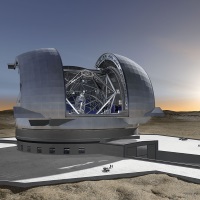21st Century Telescopes

Tuesday 16th September, 2014
 |
Our speaker was Professor Michael Merrifield from the University of Nottingham who came to talk to us about "21st Century Telescopes", of which he has first-hand experience as he is currently involved in the development of the European Extremely Large Telescope (EELT).
The EELT is currently being constructed on a mountain-top in the Atacama Desert in northern Chile. In fact the first stage of the construction, in June this year, involved flattening the top of Cerro Armazones using enough explosives to remove a million tonnes of rock. If all goes to plan the EELT will be finished in 2022 and "first light" will be achieved in 2024; the term first light meaning the very first time the telescope will record an image.
Once built, the EELT will become the largest telescope in the world to observe in visible and infrared wavelengths of light. Its mirror will be 39 metres across and consist of a thousand hexagonal mirror segments each 1.45 metres across. Even though the atmosphere is extremely translucent at these altitudes in Chile due to the lack of water vapour and generally cloud-free days, each of the mirror segments will benefit from engineering systems known as active and adaptive optics.
Because the telescope is ground-based, unlike telescopes in space such as the Hubble Telescope, it will be collecting light that has had its path altered due to the shifting layers in the atmosphere. To try and correct for the zigzags that occur before a ray of light reaches the telescope the EELT will use six lasers that shine up into the atmosphere and excite sodium atoms so that they give off light. The light from these "artificial stars" can then be analysed to see how the Earth's atmosphere has degraded their images, and real-time adjustments can be made to the telescope's optics in order to improve its image of its target object in the night sky. The use of these false stars comes under the heading of adaptive optics.
Similarly, active optics improves the telescope's image by ensuring that the telescope's structure (mainly the shape of its mirrors) does not alter due to temperature changes or when gravity distorts the mirrors due to the angle of observation changing. As materials technology has improved this effect has become less noticeable and so on world-class large telescopes, such as the EELT, it is the adaptive optics systems which make more of an impact on the quality of the final image.
Once EELT is up and running astronomers hope to study exoplanets similar to Earth, the evolution of the first galaxies and make direct measurements of the accelerating expansion of the Universe. Meanwhile, there have been various spinoffs from technology used for the project. These include much better polishing of artificial hip joints so that they last much longer and new algorithms to process blurred MRI images of babies that, naturally, are unable to stay still for the process.
This article was written for the club news column of the Stratford Herald. The actual lecture explained the subject at a deeper level.
